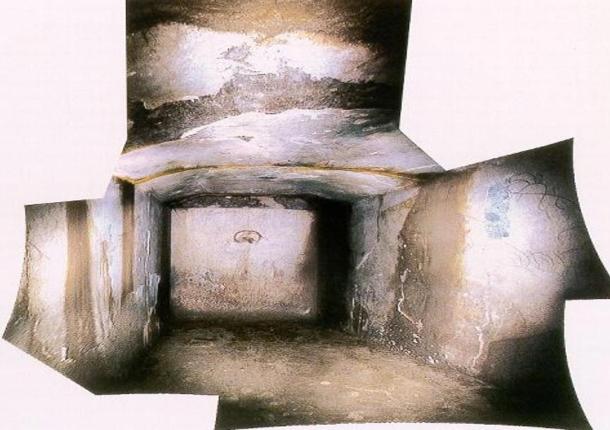
Kitora Tomb Star Chart is Declared the Oldest in the World
The Japanese Agency for Cultural Affairs have announced that a star chart discovered in ancient Asuka in the country’s Nara Prefecture, is based on much older celestial observations made in China, The Asah Shimbun has reported. The star chart was discovered in the Kitora Tomb in Asuka village in 1998, a site dated from the late 7 th century to early 8 th century, making it the oldest existing star map of its kind in the world.
It features 68 constellations in which the stars are depicted using gold discs. The movement of celestial objects is also represented in the form of three concentric circles with another circle depicting the movement of the sun. The Polar Star is depicted at the center.

Detailed diagram of the Kitora Tomb star chart, Asuka, Japan (Asahi Shimbun)
Mitsuru Soma, an assistant professor of position astronomy at the National Astronomical Observatory of Japan, and Tsuko Nakamura, a researcher of modern astronomy with Daito Bunka University’s Institute of Oriental Studies, worked with the Japanese Agency for Cultural Affairs and Nara National Research Institute for Cultural Properties in order to investigate where in China the initial observation was made. They also investigated on when the map, upon which the star chart is based, was drawn.
Analysis of digital images showed that the most likely observation sites were those located on the 34 th parallel north, including the ancient cites of Chang’an (modern Xi’an) and Luoyang, both of which were capitals of Chinese dynasties governing the middle reaches of the Yellow River.
- The discovery of a pyramid-shaped tomb in Japan that adds to mystery in Asuka
- Mirrors of Orion: Star Knowledge of the Ancient World – An Introduction
- The mysterious monoliths of Asuka Nara and the Rock Ship of Masuda
Soma and Nakamura believe the observations were made several hundred years before the Kitora Tomb was constructed. Soma thinks it may have been between 240 and 520 AD, while Nakamura prefers a time period of 120 to 40 BC. Using this as a basis, Kazuhiko Miyajima, a former professor of East Asia astronomy history at Doshisha University, has suggested that the star chart depicts the sky in 65 BC, in either Pyongyang, the capital of North Korea, or Seoul, the capital of South Korea.
The Kitora Tomb is located in an ancient tumulus near the village of Asuka and was first discovered in 1983. Experts believe it dates to some point between 7 th and early 8 th Centuries AD. The tomb consists of a small stone chamber just over 1 meter (3.3 feet) high, 1 meter (3.3 feet) wide and around 2.4 meters (7.9 feet) long. The walls are orientated to the four cardinal points of the compass and images on them depict the Black Tortoise of the North, the Azure Dragon of the East, the Red Bird of the South and the White Tiger of the West. These representations are accompanied by additional zodiacal images consisting of human figures with animal heads. The murals were discovered when probes were inserted into the tomb in 1983. A second probe inserted in 1998 found more images and the star chart painted on to the ceiling.

The Red Bird of the South painting, Kitora Tomb, Asuka, Japan (National Research Institute for Cultural Properties, Nara)
Many of the murals were removed 2004 and 2008 to protect them from deterioration. Some of them are being restored in a special facility in the village.
The chamber would only have been large enough to bury one person. This individual was laid to rest in a lacquered coffin which was broken during a tomb robbery and the fragments were scattered on the floor. The chamber also contains grave goods and shards of human bone. Artifacts discovered at the site include a gold fitting and pieces of a decorated sword. The evidence suggests an adult male of mid to late age, probably of an aristocratic background.

Composite of images of the inside of the Kitora Tomb, Asuka, Japan (Scientific Research on Kitora Tumulus)
The tomb has been designated a special historic site by the Japanese government and its discovery has encouraged a new tourist culture, among them amateur archaeologists with a passionate interest in ancient tombs and burial mounds. Japanese burial mounds (kofun) are now drawing record crowds. For example, a small music and dance festival held recently at the Imashirozuka Kofun earthen mound, in Takatsuki, Osaka Prefecture, attracted around 19,000 people. It was the fourth such event at this site, the first festival being held there in 2012.
- Moat ruins found in Japan may be part of a burial mound for an ancient emperor
- Dog Days of Summer: The Rising of the Dog Star, Sirius
- Australian Original Astronomical rock Engravings will Rewrite World History
The discovery of the star chart is now the subject of much debate, prompting further discussion about the history of astronomical technology in Japan. A number of scientific papers have been published on the topic, including by Professor Miyajima who argues that such charts were often used for ritual and divination.
Featured Image: The star chart painting on the ceiling of the Kitora Tomb, Asuka, Japan (Wikimedia Commons)















